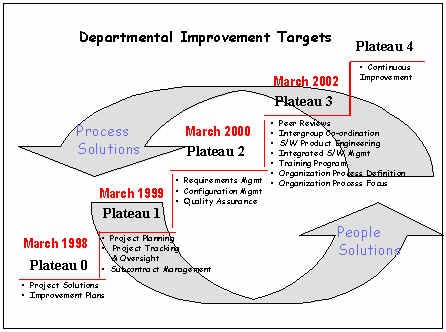Common menu bar links
Breadcrumb Trail
Institutional links
Chief Information Officer Branch
IT Project Review and Oversight
Enhanced Management Framework
ARCHIVED - A Strategy for Implementing Risk Management in the Federal Government
 This page has been archived.
This page has been archived.
Archived Content
Information identified as archived on the Web is for reference, research or recordkeeping purposes. It has not been altered or updated after the date of archiving. Web pages that are archived on the Web are not subject to the Government of Canada Web Standards. As per the Communications Policy of the Government of Canada, you can request alternate formats on the "Contact Us" page.
Appendix 2:
Enhanced Framework Implementation Plateaux
- At first view, implementation of the Enhanced Framework may appear to be complex and somewhat daunting. It is also apparent that in these times of shrinking resources and multiple priorities departments cannot do everything at once. Consequently a strategy has been defined that allows departments to approach its implementation in a step-wise manner.
Figure 2: Departmental Improvement Targets

Figure 2: Departmental Improvement Targets � Text version
Plateau 0 provides departments with the opportunity to implement the project solutions immediately and to plan the strategy, tactics and implementation approach for the next three plateaus. These project solutions include Risk Management. This approach allows departments to implement those solutions that will immediately increase the likelihood for success within specific projects.
Organizations cannot be improved over night. These improvements require time, dedication and perseverance. Plateaus 1-3 address the larger organizational processes that must exist for projects to be consistently successful over the longer term. The implementation of both the people and process solutions, together with improvements to the key process areas identified does not occur only once. Rather, this process is cyclical in nature, with improvements planned, implemented, reviewed and then improved upon again.
Departmental Improvement Plateaux
This Departmental Improvement Plateaux do not dictate the approach that will be used by departments to improve but rather focuses on the concrete steps towards the ultimate goal of significantly improving the government's ability to deliver and manage IT projects. Developed independently from any methodology or improvement model, this path reflects the initial Enhanced Framework findings and the priorities of government departments.
Plateau 0: Project Solutions and Improvement Plans
This first plateau is designed to ensure that departments immediately gain value from the implementation of specific project solutions related to the Governance Structure of a project. These include defining: a clear and explicit business case, the procurement strategy, the project charter; the gating and review process; the project planning and control mechanisms and conducting a risk assessment.
The second objective of plateau 0 is to ensure that departments plan for the next three plateaus. Without a plan, together with resource estimates, it is unlikely that departments will make the improvement gains as identified in the Enhanced Framework. It is expected that departments will have implemented the project solutions and created the plans for implementation of the next three plateaus by March of 1998.
Plateau 1: Project Planning
This plateau addresses the initial phase of any project namely project planning, project tracking, and oversight and subcontract management. The processes are aimed at linking the project objectives to the organizational goals and answering the fundamental questions of planning: what, who, by whom, when, how and how much. The objective of this plateau is to achieve proper planning for projects in government departments and to establish adequate visibility into actual progress, thus allowing management to take effective action when the project deviates from plan. It is also in Plateau 1 that initial actions are taken to develop project managers and establish the tools to support them and the project. Departments are to have implemented these improvements by March of 1999.
Plateau 2: Product Planning
Plateau 2 seeks to establish, at a departmental level, the controls and processes to be followed that will ensure:
- changes to requirements follow a clearly defined effective change management process;
- product integrity is maintained throughout the life of the project; and
- quality of the product is acceptable within defined parameters.
Actions continue to be taken to ensure the implementation of process solutions and the development of the Project Management cadre.
Plateau 3: Organizational Effectiveness
The third Plateau deals with making the processes and practices established in Plateaus 0-2 the way that government departments do business for all their projects. The objective of this Plateau is to ensure that the best processes implemented in one project within a department are carried through to the other projects within the organization. Organization-wide issues such as the training of personnel and the documentation of processes are also addressed at this level.
Plateau 4: Continuous Improvement
The final Plateau deals with continually improving the organizational effectiveness of departments when managing and delivering projects (e.g. do projects faster and better). This Plateau includes quantitative techniques to measure and improve processes.
This path for improvement will guide Enhanced Framework implementation by establishing clear priorities, objectives and time frames.
